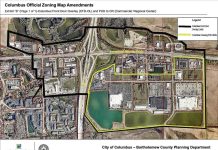During snow season, a school superintendent may make more decisions before 5:30 a.m. than other people make all day.
That’s because 5:30 a.m. on a school day is “go time,” as Bartholomew Consolidated School Corp. leader John Quick describes it.
Quick considers that his self-imposed deadline to let parents, students, staff members, bus drivers and employers know whether school is being canceled or that start time is being delayed two hours because of weather conditions.
BCSC buses are the road at 6 a.m., making the timing of decisions crucial.
[sc:text-divider text-divider-title=”Story continues below gallery” ]
It’s a decision Quick makes after consulting others, both within BCSC and outside the corporation, and after research into how weather conditions could change within minutes and hours of his decision.
“The day I retire will be the day I finally get that decision right,” Quick joked.
Complaints about whether school is held, called off or delayed are part of the landscape of being a school superintendent, and Quick said he answers every phone call, email or communication about those decisions.
BCSC called off school four out of five days last week.
Two of the cancellations last week began with two-hour delays announced the night before, with final decisions made in the morning not to hold school.
Students did have two-hour delays Friday, plus Monday and Tuesday of this week, with exceptionally cold conditions contributing to those decisions.
Quick said he is not a big fan of two-hour delays, particularly if there is a chance that school could be called off altogether. Sometimes, when the weather forecasters predict better conditions two hours from the normal school start time, there are advantages to starting several hours later, he said.
Two-hour delays mean:
- Fewer vehicles on the road that buses must work around.
- More daylight to drive in.
- Potentially warmer conditions.
On top of that, there are no state penalties or requirements to make the two hours up.
Most of the time, two-hour delays are called the night before to assist parents who need to make arrangements for their child, Quick said.
The school corporation sends out cellphone text messages to about 5,000 households notifying them of delays or closings. Email alerts also are issued. Media outlets in Columbus and Indianapolis are notified, giving parents another source of closing information.
As far as armchair quarterbacking, Quick said he received about six complaints one day last week when school was called off completely. After Friday’s two-hour delay day, he had 12 phone calls and six emails complaining that students were in school.
How decisions are made
On days when school officials know the next school day might become a snow day, conversations among Quick, director of facilities and operations Steve Forster and director of transportation Karen Wetherald begin early. Those conversations resume at 4 a.m. the following day.
Quick said he also reaches out to area superintendents at Flat Rock-Hawcreek, Greensburg Community Schools, Decatur County Schools, Seymour Community Schools and Brown County Schools. Superintendents will conduct text messaging conversations about what each is considering.
When snow or ice is in the forecast, Quick makes sure to check in with Monroe and Brown counties.
“Whatever happens there happens to us about an hour later,” Quick said.
School officials check with the Bartholomew County Sheriff’s Department and workers at the Columbus City Garage on road conditions. With about 600 miles of road covered by BCSC buses, officials must make sure there is plenty of time for two passes on each road to clear both lanes of snow, Quick said.
Subzero temperatures are also a concern, as a potential danger to students and how freezing temperatures affect buses, he said. When the temperature reaches 10 below zero or lower, diesel fuel starts to gel, and some bus stop arms can malfunction.
But every possible snow day or delay is a unique situation of timing and circumstances, Quick said. Wind speed, wind chill, the chance of precipitation, how much and in what form, are all variables.
Quick consults a variety of weather forecasting websites.
The National Oceanic and Atmospheric Administration is a mainstay because it provides grids forecasting how snowfall or temperatures will fluctuate over an entire day. NOAA weather data is collected at the Columbus Airport and at Jonesboro.
Quick also checks several websites that stream radar precipitation, showing where the snow or ice is heading and when it could arrive.
Using a combination of these factors and input from school administrators and other superintendents, Quick makes the call.
He admits that on occasion he can get it wrong.
In one instance, an ice storm was approaching the county from the west. Brown County had freezing rain and ice, the temperature was at 30 degrees, and the precipitation was heading toward Bartholomew County, Quick said. After calling off school for the day, the local temperature climbed to 33 degrees, and Bartholomew County got rain, not ice.
Heavy snow is an easier call, he said.
If the 4 to 5 inches of snow Bartholomew County received on Saturday would have occurred during the week, it likely would have resulted in two lost school days, he said.
Late start for measurable snow
Quick said having the first snow days of the school year come in the third week of February is unusual.
Last school year’s long and snowy winter had eight snow days. The first was on Dec. 6, 2013, when about 6 inches of snow fell. Over the next two months, the local snow total climbed to 30 inches.
School cancellations meant rescheduling class for the entire second week of spring break and adding two days at the end of the year.
But adding days into June isn’t something the school corporation wants to do, Quick said.
Families have made plans, the quality of the school day suffers at the end of the year — since it’s warmer — and summer vacation is beckoning.
Quick said the school corporation guarantees five days and two weekends for spring break — but that’s all as far as those vacation days.
He knows how many snow days are still in play and already is looking at the extended weather forecast to see how the weather game will play out and whether any more days might be needed.
“Just get me to March,” he said of the weather forecasts.
[sc:pullout-title pullout-title=”Why school was closed, delayed” ][sc:pullout-text-begin]
Here’s a recap of the most recent snow days and school delays, with the reason school was closed each day. Superintendent John Quick said “go time” to make a decision whether school is called off is 5:30 a.m. on the day in question. The school corporation tries to call two-hour delays the night before if there is a chance school could be held the following day.
Feb. 16: Two-hour delay called night before and closed at 5:15 a.m. because of snow.
Feb. 17: School closed, snow.
Feb. 18: Two-hour delay called night before, then closed, snow squalls and blowing and drifting snow.
Feb. 19: School closed, bitterly cold subzero temperatures.
Feb. 20: Two-hour delay for cold temperatures, then school was open.
Monday: Two-hour delay because of cold temperatures.
Tuesday: Two-hour delay because of cold temperatures.
[sc:pullout-text-end][sc:pullout-title pullout-title=”Makeup days” ][sc:pullout-text-begin]
Last week’s snow and cold and four snow days means BCSC student will make up those days on March 25, 26 and 27 and April 3, which is Good Friday.
[sc:pullout-text-end]




